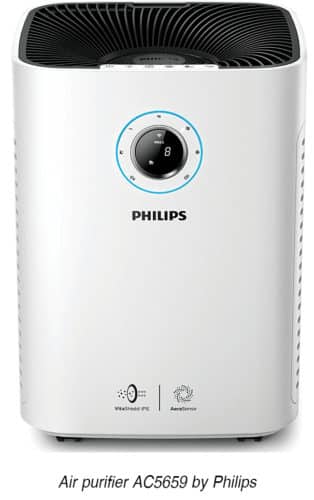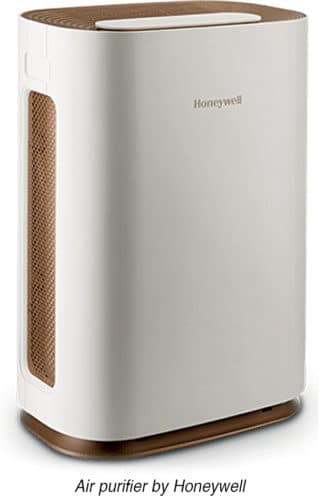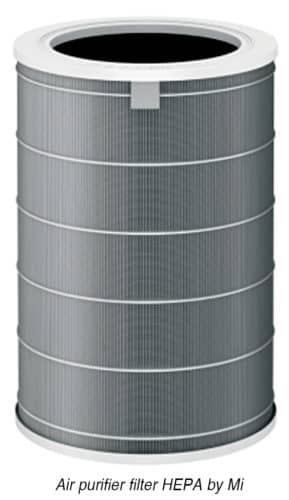There is a general perception that a house provides a protective shield from outdoor toxic air pollution. But very few people know that indoor air is as bad as outdoor air. Indoor air is, in fact, much more polluted. Studies indicate that carbon-dioxide and various gases in the form of volatile organic compounds are present indoors as the main pollutants, which are hazardous. These pollutants get much more concentrated inside the home.
On an average, we spend approximately eighty per cent of our time indoors. And what is worse is that human eyes can only see particles larger than ten microns. You can imagine the lethal effects of the invincible air-borne particles present in the air. Therefore indoor air pollution is a major cause for concern as it breeds a host of problems including such diseases as lung and heart, mental health problems and so on. Considering the adverse impact of pollution on health and environment, an air purifier is no more a luxurious indulgence but a requisite to lead a healthy life.
Types of air purifiers
The core purpose of air purifiers is to cleanse the air. These are available in various shapes, sizes and colours; however, not all work the same way. Air purifiers are equipped with different technologies and features and, hence, effectiveness varies from one product to another.
HEPA technology
High efficiency particulate air (HEPA)-based air filters are the most efficient for air purifiers. Usually made of fibreglass, HEPA filters have a standard trapping of at least 99.7 per cent, which effectively removes particles as small as 0.3 microns.

These filters typically last two to four years. This technology has an extra edge in trapping harmful particles in comparison with other air purifiers. These are effective in removing dust, pollen, dust mites, pet dander, mould and more. With HEPA-based air purifiers, these unhealthy particles hardly get released back into the air and also do not generate ozone gas.
The only flip side is that these cannot remove chemicals, odours, gases, germs and viruses (0.01 microns and below) successfully. Nonetheless, these are the most sought-after when it comes to air purifiers.
Activated carbon air filters
These have many small pores between carbon atoms that are highly absorbent with good chemical bonding. These are effective in trapping gases, chemical emissions, odours and smoke. The best part about activated carbon air filters is that these can curb pollutants from contaminating the atmosphere by not releasing them back into the air.
Further, these do not generate any hazardous byproducts or ozone gas. However, these filters get affected with time as contaminants get accumulated or trapped on the pores in the filters. Thus, the need to replace the filters is required from time to time.
Ozone-generating air purifiers
Ozone is an extremely reactive oxidant and, thus, highly effective at reacting and removing odour-causing bacteria and air-borne chemicals. These filters can even eliminate cigarette smoke odours but are not capable of cleaning the air completely.
Ozone air purifiers are not effective in removing such particles as dust and pollen. Besides, these contain negative ion technology, and also produce ozone gas. Thus, it is recommended to turn these off when not required, and it is good not to switch on when weather conditions are favourable. The cautionary aspect of these devices is that these can cause long-term lung and skin damage and other exposed ailments.

Myths around air purifiers
There are certain myths surrounding air purifiers that are baseless and illogical. There is a wrong perception floating around that air purifiers are not required in air-conditioned rooms. However, the two have no correlativity in terms of functionality. ACs cannot eliminate invisible pollutants; these are primarily used for cooling hot air using an evaporator coil, compressor and condensor coil.
Many people assume that air purifiers can kill all kinds of odours, which is not true. Most filters are effective in trapping tiny particles but not odour. Air purifiers that come with activated carbon filters can bring down the odour level. Some difference can be experienced with activated carbon filters but not with other air purifiers.
Then, doors and windows should be kept shut to boost effectiveness of air purifiers. This is a wrong perception, which causes a rise in carbon-dioxide. It is important to note that air purifiers do not remove carbon-dioxide. Therefore it is advisable to open doors and windows occasionally to enjoy carbon-dioxide-free air.

When dusting, cooking, burning incense sticks, smoking cigarettes, etc, windows should be open. Fresh air circulation is important to eliminate particles faster and remove carbon-dioxide. But in exceptional circumstances, when air is particularly bad outside, doors and windows should not be opened too often.
Last, there is a common misunderstanding that if an air purifier has a HEPA filter, it can solve all pollution-related problems. Even if the air purifier has a HEPA filter, its effectiveness lies in its size and design. It is important to figure out coverage area of each purifier and size of the room. Keeping an air purifier meant for a small room in a large one will weaken its effectiveness. Capacity of the air purifier has to match the size of the room.
Moreover, design of the air purifier is important, as it has a high chance of leaking non-purified air from the filter. Hence, a HEPA filter alone is not a relying factor to absorb particles and clean the air completely.
Use of air purifiers
The Indian air purifier market was under-penetrated. Air purifiers were perceived to be a lifestyle product rather than an essential element to avoid breathing- and other health-related issues. Besides, there was the wrong perception that indoor air quality was better and safe than outdoor, which consequently led to low consumption of air purifiers.
However, with deteriorating air pollution levels coupled with increasing awareness of its harmful effects, there is definitely a changed approach with regards to air purifiers. Industry insiders indicate that consumption of air purifiers is currently picking up. It is likely to register an exponential growth rate in the coming years.
As per reports, it is estimated that air purifiers are one of the fastest-growing products in the home appliances space. About 300,000 air purifiers are sold annually in India, indicating a growth rate of thirty per cent every year.










